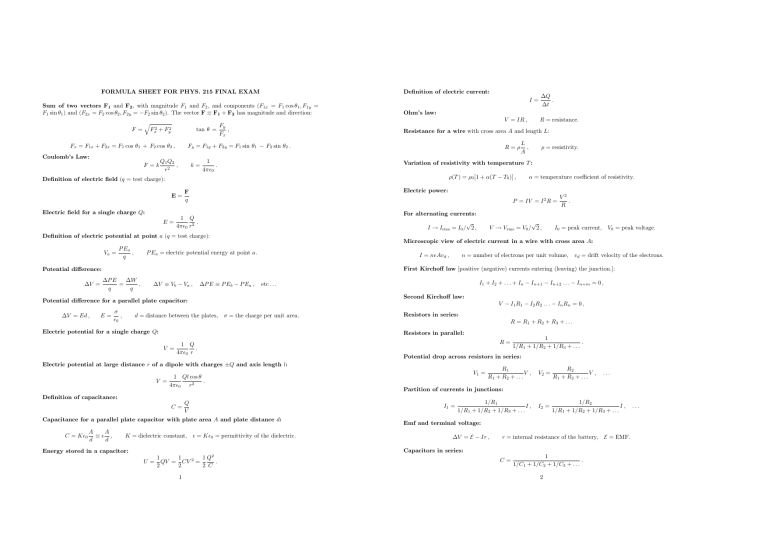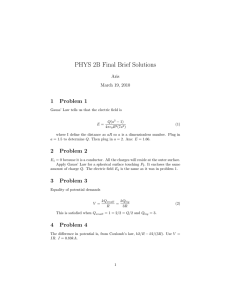FORMULA SHEET FOR PHYS. 215 FINAL EXAM Sum of two
advertisement

FORMULA SHEET FOR PHYS. 215 FINAL EXAM Definition of electric current: Sum of two vectors F1 and F2 , with magnitude F1 and F2 , and components (F1x = F1 cos θ1 , F1y = F1 sin θ1 ) and (F2x = F2 cos θ2 , F2y = −F2 sin θ2 ). The vector F ≡ F1 + F2 has magnitude and direction: q F = Fx2 + Fy2 tan θ = Fx = F1x + F2x = F1 cos θ1 + F2 cos θ2 , Coulomb’s Law: Fy , Fx I= Ohm’s law: V = IR , 1 k= . 4π0 R=ρ ρ(T ) = ρ0 [1 + α(T − T0 )] , Electric field for a single charge Q: E= P Ea , q F q For alternating currents: √ I → Irms = I0 / 2 , 1 Q . 4π0 r2 √ V → Vrms = V0 / 2 , V2 . R I0 = peak current, V0 = peak voltage. Microscopic view of electric current in a wire with cross area A: P Ea = electric potential energy at point a. I = neAvd , n = number of electrons per unit volume, vd = drift velocity of the electrons. First Kirchoff law [positive (negative) currents entering (leaving) the junction.]: ∆P E ∆W ∆V = = , q q ∆V ≡ Vb − Va , ∆P E ≡ P Eb − P Ea , σ E= , 0 I1 + I2 + . . . + In − In+1 − In+2 . . . − In+m = 0 , etc . . . Potential difference for a parallel plate capacitor: d = distance between the plates, σ = the charge per unit area. Second Kirchoff law: V − I 1 R1 − I 2 R2 . . . − I n Rn = 0 , Resistors in series: R = R 1 + R2 + R3 + . . . Electric potential for a single charge Q: Resistors in parallel: V = 1 Q . 4π0 r R= 1 Ql cos θ . V = 4π0 r2 V1 = Q V Capacitance for a parallel plate capacitor with plate area A and plate distance d: K = dielectric constant, = K0 = permittivity of the dielectric. R1 V, R1 + R 2 + . . . I1 = 1/R1 I, 1/R1 + 1/R2 + 1/R3 + . . . U= 1 Q2 1 1 QV = CV 2 = . 2 2 2 C 1 R2 V, R1 + R 2 + . . . I2 = 1/R2 I, 1/R1 + 1/R2 + 1/R3 + . . . ... Emf and terminal voltage: ∆V = E − Ir , r = internal resistance of the battery, E = EMF. Capacitors in series: Energy stored in a capacitor: V2 = Partition of currents in junctions: Definition of capacitance: C= 1 . 1/R1 + 1/R2 + 1/R3 + . . . Potential drop across resistors in series: Electric potential at large distance r of a dipole with charges ±Q and axis length l: A A C = K0 ≡ , d d α = temperature coefficient of resistivity. P = IV = I 2 R = Potential difference: ∆V = Ed , ρ = resistivity. Electric power: Definition of electric potential at point a (q = test charge): Va = L , A Variation of resistivity with temperature T : Definition of electric field (q = test charge): E= R = resistance. Resistance for a wire with cross area A and length L: Fy = F1y + F2y = F1 sin θ1 − F2 sin θ2 . Q1 Q2 F =k 2 , r ∆Q . ∆t C= 1 . 1/C1 + 1/C2 + 1/C3 + . . . 2 ... Capacitors in parallel: Velocity of light in a medium: 1 v=√ . µ C = C 1 + C2 + C3 + . . . Force F on an electric current I in a magnetic field B: Relation between frequency ν and wavelength λ: F = IlB sin θ . λ= Force F on an electric charge q with speed v in a magnetic field B: Mirror equation: F = qvB sin θ . Magnetic field due to a straight wire: 1 1 1 + = , do di f µ0 I B= . 2π r do = obj. distance, di = image distance, f = F µ0 I 1 I 2 = . l 2π L di hi =− , ho do m= ho = object height, hi = image height. Index of refraction: n= Ampère law: c . v Snell’s law: B|| ∆l = µ0 I Magnetic field inside a solenoid with n loops per unit length: ni sin θi = nr sin θr , θi (ni ) and θr (nr ) = incident and refraction angles (indices of refraction). Total internal reflection: B = µ0 nI . sin θc = Magnetic flux: n2 , n1 n2 < n 1 . Power of a (thin) lens: ΦB = BA cos θ . Faradays’ law: E =− P = Thin lens equation: ∆ΦB . ∆t Emf produced by an electric generator: E = N BA ω sin ωt , Transformers: R = focal length of the mirror w/ radius R. 2 Lateral magnification of a mirror: Force between two straight wires of length l and distance L: X c . ν 1 1 1 + = . do di f Lateral magnification of a thin lens: N = number of loops, ω = angular frequency of the rotor. m= VS NS = , VP NP P = primary, S = secondary. hi di =− . ho do Wavelength of light in a medium with index of refraction n: λn = Inductance between two coils: E1 = −M 1 . f ∆I2 , ∆t E2 = −M Self-inductance: E = −L ∆I . ∆t ∆I1 . ∆t Double slit (or diffraction grating) interference [d=slit distance, m=fringe order]: 1 λ (dark fringes) d sin θ = mλ (bright fringes) d sin θ = m + 2 Single slit interference [D=slit width]: D sin θ = mλ Energy stored in a magnetic field: 1 B2 1 . U = LI 2 = 2 2 µ0 Velocity of light in vacuum: c= √ 1 . 0 µ0 3 λ . n (bright fringes) Interference of a thin film with thickness t [θ=incidence angle]: 1 λ cos θ 2t = mλ cos θ or 2t = m + 2 depending on the index of refraction of the two materials at the reflection boundary. 4

